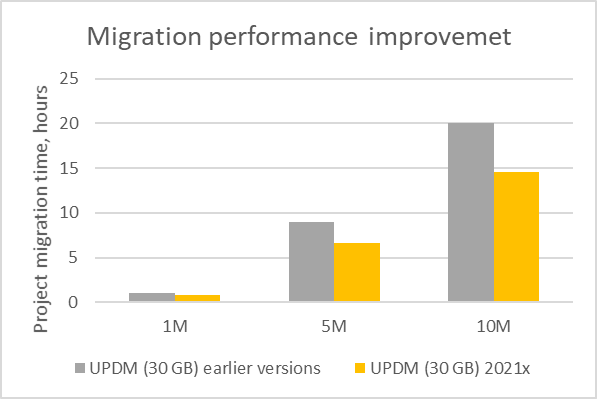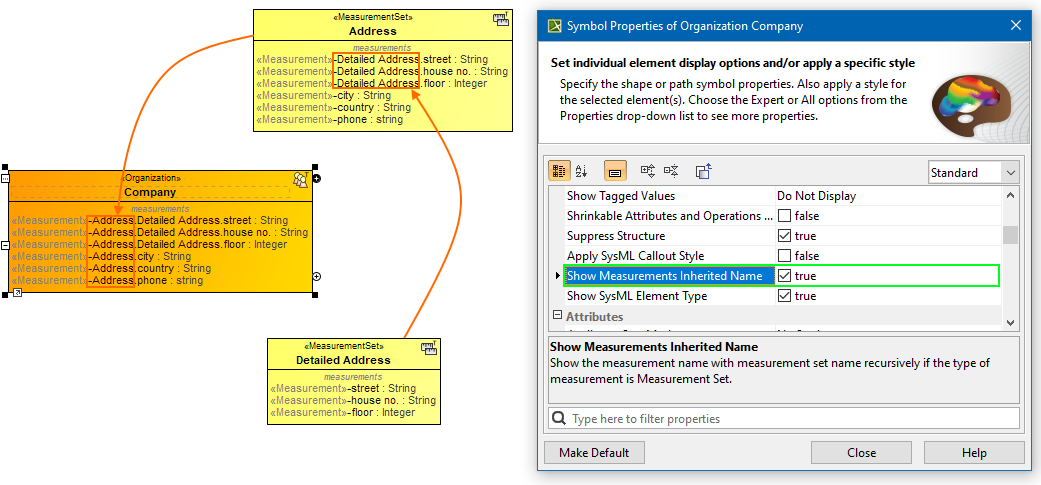UAF Plugin
Released on: February 12, 2021
This release introduces significant performance and scalability upgrades in key product areas: migration, converting between frameworks, building matrices, Merge, Teamwork Cloud project load, Teamwork Cloud repository disk footprint, table loading, and copy/paste operations.
Additionally, this version adds support for the UAF 1.1 Profile, new diagrams and tables, and a number of usability and traceability improvements.
Contact your sales representative, and don't forget to give us your feedback on Twitter or Facebook.
- Performance Improvements
- Methods and Standards
- Diagrams and Tables
- Usability Improvements
- Traceability Improvements
- Other
- Key issues fixed
Performance Improvements
In this version, projects containing 1, 5, and 10 million elements were tested in both UPDM and UAF scopes. After receiving the results, improvements in migration, converting between frameworks, and building matrices were made for better performance.
Migration
The migration from UPDM2 to UAF 1.1 and from UAF 1.0 to UAF1.1 has been optimized and takes less time than in earlier versions.
The comparison of migration time depending on the project size
Converting between frameworks
The conversion between frameworks has been optimized. The following table shows the results of converting a project containing approximately 2 million elements and hundreds of framework packages, which needed to be moved or renamed:
Earlier versions | 2021x version |
|---|---|
| The modeling tool stops responding after 30 min | ~ 1 hour |
Building matrices
The scope for predefined matrices is no longer set by default. Now all matrices will start to build after the row and column scope is selected.
| Earlier versions | 2021x version |
|---|---|
Load predefined matrices in the projects with 10 million elements: ~ 1-3 hours. Sometimes more. | Create a new matrix: instantly (~1-2s) |
Methods and Standards
UAF 1.1 Profile Support
Beginning with this version, the UAF 1.1 profile is supported. Therefore the following migrations will be necessary:
- UAF 1.0 to UAF 1.1. Learn more about the changes >>
- UPDM 3 (UAF 1.0 beta) to UAF 1.1. Note that there is no direct migration in this case. Learn more about the migration process >>
- UPDM 2.1 to UAF 1.1. Learn more about the changes >>
Evolution of standards
Diagrams and Tables
- New Actual Enterprise Phases Gantt Chart shows how actual enterprise phases change over time. Learn more >>
- New Date and Time Summary Table depicts all dates and times specified in the ISO8601 date-time format. Learn more >>
- New Personnel Forecast, Resources Forecast, and Standards Roadmap diagrams are implemented, improving the way they are created and used. The Personnel Forecast, Resources Forecast, and Standards Roadmap diagrams created with earlier versions of the modeling tool will be marked as deprecated and will be available only for review purposes.
- The Deployment diagram has been enhanced. The Strategic Deployment table is renamed the Strategic Actual Deployment table and you can now create it using an Actual Resources Deployment Creation Wizard. Moreover, the Deployment Milestones wizard is renamed the Actual Resources Deployment Wizard and enhanced. Learn more >>
- A technology preview of the Hierarchical Measurements table. Please note that if you open a project created with earlier versions, the Measurement tables of those projects will be empty. However, you can create them anew.
Usability Improvements
- The new Personnel Gantt Chart property Display Actual Persons in Different Lines was implemented. Now you can choose to see each Actual Person in separate lines.
In the Gantt chart Options area, you can choose to mark a required period of time. One of the following Marking Modes are available:
- None. Nothing will be marked.
- Period of Time. Choose to mark a period of time. For this mode, you can select the Start and End dates to be marked.
- Period of Actual Enterprise Phase. Choose to mark a period of the Actual Enterprise Phase. The time frame will be marked according to the Start and End dates set for the selected Actual Enterprise Phase.
The Create Association on Part Creation project option is set to True. This means that when you create parts in the Part compartment of the Resource and Operational performers, the appropriate association is also created in the model.
- A new Symbol property Show Measurements Inherited Name allows you to display the inherited measurements name through the dot notation when the Property Set is applied as a type.
Traceability Improvements
The Implementation matrices have been enhanced. Now, by default, the traceability is shown according to the following criteria:
- Mapping Using Milestone (Actual Resources and Resources)
- Mapping Using Milestone (Resources Performers)
- Mapping Using Milestone (Service Specification)
- Mapping Using Milestone (Actual Resources)
You may hide some mapping rules from a Matrix by changing the Dependency criteria in the Specification window.
Learn more about working with the implementation matrices >>
Other
- The new version of the UJTL version (20200115) is now available. You can choose the library version when creating a new project.
When an old project (UAF 1.0 or UPDM2) is opened with the latest version (UAF plugin), stereotypes for nonDSL'ed associations should be applied:
- when the association is between OperationalAgent, the <<OperationalAssociation>> stereotype is applied.
- when the association is between ResourcePerformer, the <<ResourceAssociation>> stereotype is applied.
- Operational Signal/Resources Signal now applies automatically for the DSL'ed signal.
- The derived properties of ActualResponsibleResources, ActualOrganization, ActualPost, and ActualPerson were renamed:
- ownsActualProject renamed to managesActualProject,
- responsibleForActualResponsibility renamed to ownsActualResponsibility,
- responsibleForActualProjectMilestones,
- responsibleForActualResponsibility renamed to managesActualResponsibility.
- ownsActualProject renamed to managesActualProject,
When working with the predefined matrices, you can make some changes to the default settings, such as changing the row or columns element type, dependency criteria, or directions. You can restore the following settings to default at any time:
- Description
- Direction
- Dependency Criteria
- Show Elements
- Column Element Type
- Row Element Type
Key issues fixed
- The issues concerning the All Views report have been fixed. The matrices and Producing/Consuming OperationalActivities/Functions are now included.
- The issue where the PartProperty stereotype instead of ReferenceProperty stereotype was applied for the role when the Aggregation relation is created has been fixed.
- The additional stereotype is no longer applied for the element with custom stereotypes after migration from UPDM2 to UAF.
- [UPDM2] The issue where redundant Block stereotypes were applied for specific Environment elements has been fixed. Now only Value Type is applied for Condition, Climate, and LightCondition elements in SysML Compliance mode.
- [UPDM2] The validation rule COR2071 no longer fails in a valid situation.
- [UPDM2] The issue where incorrect metaclass element is created with Impelemnts stereotype applied when solving validation rules COM2023 and COM2047. Now the Abstract relation with the «Implements» stereotype is created.
- A resources tag value of Call Activity now is set when the BPMN compliance mode is ON.
- The issue where Operational Object Flow was not keeping project settings when BPMN compliance mode is ON has been fixed.
You can check the list of publicly available issues or your own reported issues fixed in UAF Plugin 2021x.
Note: You will be required to login. Use the same username and password as for your account for downloading products.
UAF Plugin documentation




